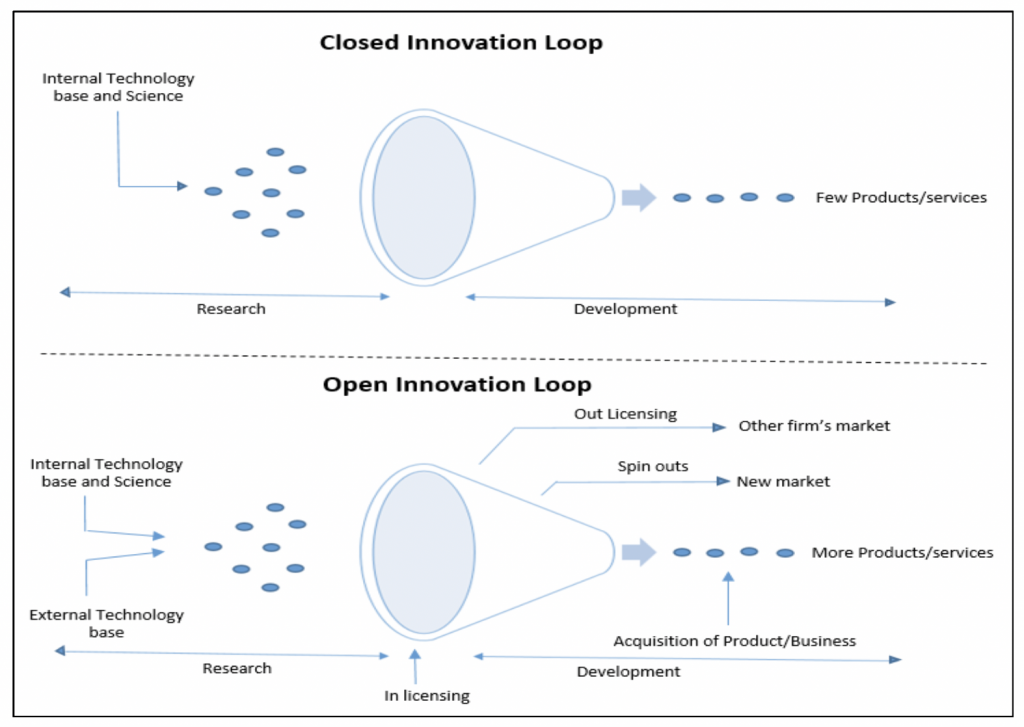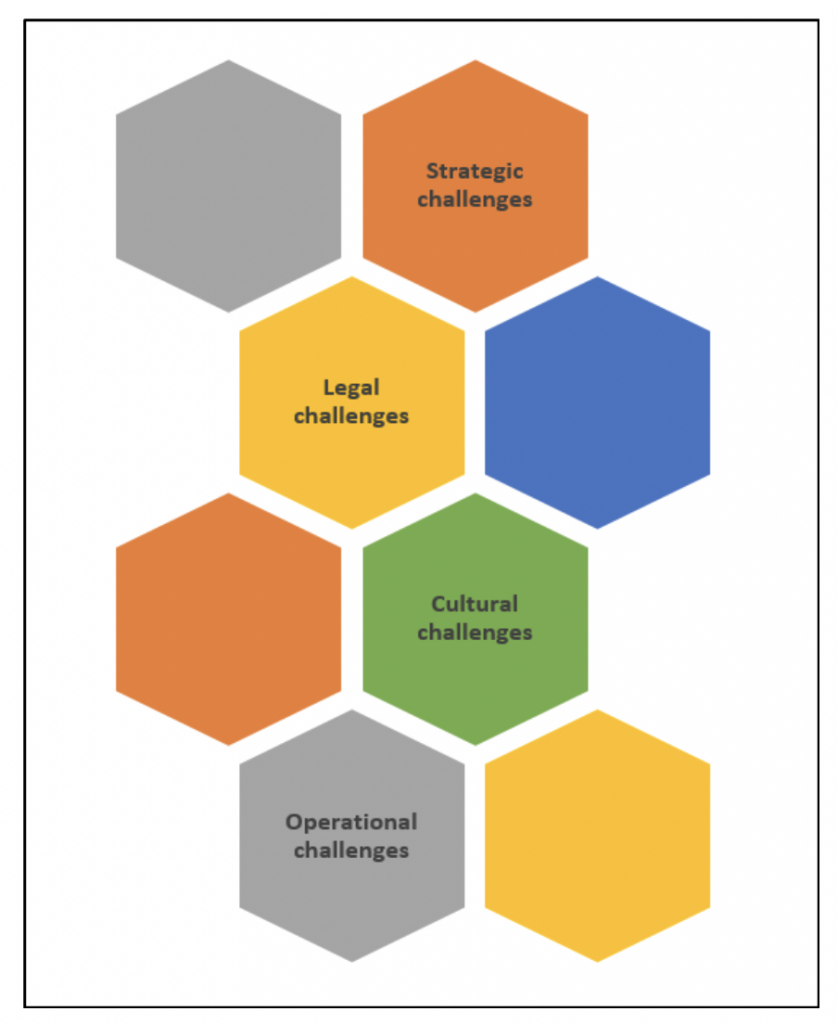Open Innovation was originally introduced by Chesbrough in his book “Open Innovation: The New Imperative for Creating and Profiting from Technology”, 2003. He defines it as “Open Innovation means that valuable ideas can come from inside or outside the company and can go to market from inside or outside the company as well. This approach places external ideas and external paths to market on the same level of importance as that reserved for internal ideas and paths to market during the Closed Innovation era”. Under open innovation model, a firm collaborates with external technology providers in order to enhance its innovative processes and bring new and better products and services in the market.
Difference between Open innovation and Closed Innovation:
Closed innovation system is based on the view that innovations are developed by companies themselves starting from the generation of ideas to development and marketing, keeping the innovation process exclusively within the company. The main focus in closed innovation is on introducing an innovative product/service in the market. In this, all people work only for the company and to be successful, the company must create all ideas within the company. Further, the company must control its intellectual property so that competitors do not profit from company ideas.
On the other hand, open innovation means opening the innovation process beyond company boundaries in order to increase one’s own innovation potential through active strategic use of the environment. In this, the R&D activities may be developed externally and main focus for them is to build a strong business model. The company works with people from both inside and outside the company. To be successful, the company must make the best use of both internal and external ideas. For intellectual property, the company must profit from the use of its OI from others, as well as it buys others’ intellectual property.

Why Open Innovation?
There are many reasons for the shift from closed innovation to open innovation over the past years. It’s not just the battle for innovation leadership that pushes organizations to open up both ways – Outside-In and Inside-Out. The closed loop model is no longer sustainable, where the internal R&D being the main strategic asset controlled all the innovative breakthroughs.
Benefits/Value of Open Innovation:
Open innovation provides a number of important benefits: i) Collaboration can expand market opportunities, providing consumers with faster access to new and better solutions. ii) It can also benefit firms, in particular through higher innovation performance, organizational learning, and shorter time to market for intentions and reduced R&D costs and risk.
Benefits of OI to Private companies: access to new markets, sharing of risks and rewards, Improvement in research and development (R&D) performance; Improvement in efficiency and cost savings; Increase in the success rate of their products/services and better royalty incomes, Improvement company reputation and customer commitment.
Benefits of OI to public sector: Strengthening the cooperation with citizens to develop social innovation projects, and providing better transfer of knowledge, people and technologies.
Challenges of Open Innovation:
As open innovation involves sharing details with partners, it may generate significant uncertainty and risk for the firm. Some of the major challenges of Open innovation include:
- Strategic challenges: Major strategic challenges include i) Some companies aren’t capable of innovating internally, rely on external sources of open innovation in the hopes of becoming more innovative, ii) selection of right types of partners to collaborate and pursue goals with is the major challenges, iii) Unclear goals, Wrong type of audience, and iv) Diminishing returns – opportunity cost Operational and structural challenges.
- Operational challenges: The most common challenges in building an effective process include: i) unclear communication, lack of stakeholder support, immeasurability and lack of strategy alignment, ii) it can be challenging to find an effective way to make sure that the ideas in the development pipeline move in a timely and structured manner, iii) The real challenge is how to find the right open innovation platform as there are several options available.

- Legal challenges: Many unexplored challenges associated with closing open innovation—the intellectual property (IP) disassembly problem. This is the problem of allocating IP rights at the closing or termination of an open innovation project or when one or more of the vital participants leaves. Technology providers must signal the value of their inventions in order to attract potential partners. When engaging with partners, firms must simultaneously disclose and protect their technologies and knowledge. Also, firms must also contribute to a collaboration without losing control over its tangible assets, while ensuring that it will own a fair share of the outcome.
- Cultural challenges: Major cultural barriers that can limit open and innovative culture are i) a negative attitude towards something that was not invented in-house. Further, NIH (Not Invented Here) syndrome (which is the tendency for management to reject any idea that did not originate within the organization) can be a real issue. Some people who are against open innovation and collaboration, are afraid of quality issues, ii) other challenge and a general misconception when it comes to open innovation is that you only have to gather good ideas. The point of open innovation is not to try to control the quality of ideas, as no one would submit bad ideas on purpose, and iii) Another challenge many organizations face is the lack of motivation and commitment to open innovation projects. Some organizations are just observing participants but not really facilitating the collaboration.
Companies must take the above challenges into consideration. Some measures can be taken to tackle these challenges with ease. Instead of being threatened by the new knowledge and variety of perspectives, members should try to find ways to embrace open company culture at all levels of the organization. For building an effective process, it should be aligned with organizational goals and strategy and communicated clearly to everyone involved. For the process to be successful, it is important that all of the key stakeholders are engaged to it. For legal perspective, effective knowledge management systems are a crucial component of successful open innovation. Companies should engage in selective sharing with partners, licensing some registered and unregistered IPRs, while opting to keep other information strictly internal to be on safe side. Companies must have to be strategic about protecting their technologies and exclusive know-how within collaborative relationships so as not to lose their competitive advantage (Lichtenthaler 2010; Pénin et al. 2011). Provisions can be made at both the assembly and disassembly stages to prepare for and benefit from subsequent IP reassembly in a sequence of project generations over time. To successfully adopt an open innovation model, a firm’s leadership must ensure adequate absorptive capacity and drive several organizational changes, including institution of an effective knowledge management strategy.
Further, managers should also consider the organizational readiness towards open innovation, and the ability of its innovators to overcome the “not invented here” and “not sold here” syndromes. Team should be fully involved and maintain the motivation at any level of the process, and they must keep constant focus on enhancing and rewarding collaboration.
Future of Open Innovation:
OI has great perspectives as it extends unlimited and valuable opportunities to provide customers with variety of innovative products and services. It has no limits as long as it leads to market needs. In future, organizations will continue to open their innovation – not only because of strong belief in the benefits of OI, but also because it is the only option for them to remain competitive. Being in touch with one’s ecosystem is crucial to understand the expectations, needs and limitations of customers, partners and suppliers. Time/pace will continue to be an important differentiator.
Conclusion:
Over the past years, the approach of OI has continued its successful entry not only into large multinationals, but also in SMEs and public organizations. The idea of OI is that the organizations should make greater use of external ideas and in-house R&D ideas/technologies to bring more and better products/services in the market. Opening up an organization’s innovation requires not only a good understanding of the different benefits, but also considering the challenges impacting the success of OI. Knowing on how to tackle these practical challenges and taking proper measures can help in successful implementation of Open innovation strategy with great and successful output.
References:
- https://www.nmit.edu.my/wp-content/uploads/2017/10/Open-Innovation-the-New-Imperative-for-Creating-and-Profiting-from-Technology.pdf
- https://www.lead-innovation.com/english-blog/open-innovation-vs.-closed-innovation
- https://www.researchgate.net/figure/Differences-between-closed-and-open-innovation-models_fig6_235270464
- https://www.space-consulting.eu/media/publications/efficient-open-innovation.pdf
- https://www.viima.com/blog/open-innovation-challenges
- https://www.researchgate.net/publication/265173002_The_Challenge_of_Closing_Open_Innovation_The_Intellectual_Property_Disassembly_Problem
- https://www.researchgate.net/publication/263468599_Open_Innovation_and_Intellectual_Property_The_Relationship_and_Its_Challenges
- https://www.space-consulting.eu/media/publications/efficient-open-innovation.pdf

